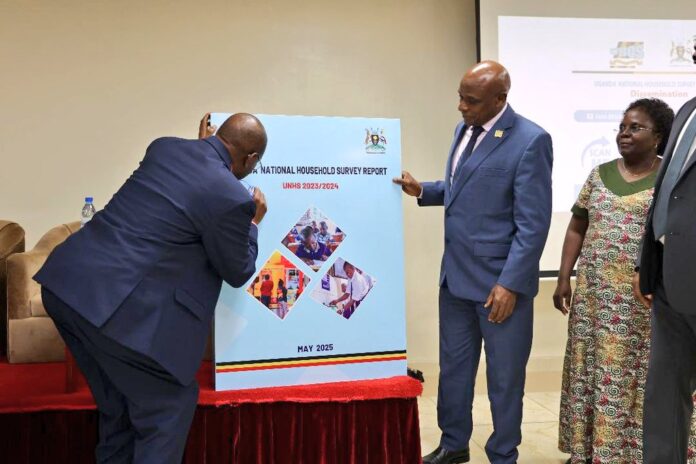The Uganda Bureau of Statistics (UBOS) recently unveiled the comprehensive findings of the Uganda National Household Survey (UNHS) 2023/24, offering a detailed snapshot of the nation’s socio-economic landscape.
Launched on May 15th, 2025, at a national event in Kampala, the survey, the eighth in its series, paints a picture of both progress and persistent challenges, particularly concerning regional disparities in poverty.
While the national poverty rate demonstrates positive trends, the report highlights the Busoga sub-region in Eastern Uganda as an area of significant concern.
Busoga: A Poverty Hotspot
The UNHS 2023/24 reveals that Busoga bears a substantial burden of poverty, ranking as the second-highest contributor to Uganda’s total poor population.
An estimated 840,700 people in the region live below the absolute poverty line, representing 18.9% of Busoga’s population and accounting for 12.0% of the nation’s total poverty share.
While this represents a slight improvement compared to previous surveys, Busoga’s poverty rate lags significantly behind regions like Buganda (7.5%) and Ankole (3.2%).
Only Karamoja, with a staggering poverty rate of 74.2%, faces a direr situation. In Karamoja, approximately 937,500 people are living in poverty, a number nearly five times the national average and a worrying increase from 65% in the previous survey.
A Regional Comparative Glance
The UNHS 2023/24 provides a detailed regional breakdown of poverty rates, highlighting areas requiring focused intervention:
- Bukedi: 29.9% poverty rate (718,400 poor persons)
- Teso: 29.8%
- West Nile: 21.2%
- Acholi: 20.5%
- Lango: 18.8%
In stark contrast, Kampala stands out as the region with the lowest poverty rate, with only 1.1% of its population living below the poverty line. It is followed by Ankole (3.2%) and Buganda South (6.0%).
Understanding the Poverty Gap in Busoga
The survey not only highlights the prevalence of poverty in Busoga but also its depth. The poverty gap, an indicator of the resources needed to lift the poor above the poverty line, stands at 4.3% in Busoga, exceeding the national average of 4.2%. This suggests that poverty in Busoga is not just widespread, but also deeply entrenched.
Speaking at the launch, UBOS Executive Director Dr. Chris Mukiza stressed the urgent need for targeted interventions in regions like Busoga.
While government programs like the Parish Development Model (PDM) and Emyooga are designed to boost household incomes, implementation delays and reported mismanagement have hampered progress.
Child Poverty in Busoga
The UNHS 2023/24 reveals a concerning trend of child poverty in Busoga. With 21.5% of children in the region living in poverty, Busoga faces one of the highest child poverty rates in the country, surpassed only by Karamoja and Bukedi. This alarming statistic underscores the need for specific interventions to protect and support vulnerable children in the region.
Progress Amidst Disparities
Nationally, Uganda’s poverty rate has shown a positive decline, standing at 16.1% in 2023/24, a drop from 20.3% in 2019/20 and 21.4% in 2016/17. This indicates a steady improvement in overall poverty reduction, despite the persistent regional disparities.
The report also indicates a decrease in income inequality, with the national Gini coefficient dropping from 0.413 in 2019/20 to 0.382 in 2023/24, suggesting a better income distribution nationwide. Interestingly, Busoga also experienced an improvement in its Gini coefficient, decreasing from 0.353 to 0.328, signifying a narrowing income gap within the region.
Targeted Interventions are Key
During the launch, State Minister for Planning, Amos Lugoloobi, emphasized the need to focus efforts on regions with alarmingly high poverty rates, acknowledging that while national poverty reduction is a positive indicator of effective anti-poverty programs, much work remains to be done.
The UNHS 2023/24 provides invaluable data to guide policymakers, development partners, and civil society organizations in designing targeted programs that address the specific needs of vulnerable communities, particularly in regions like Busoga.
With agriculture remaining the primary source of employment in rural areas and significant disparities in access to education and healthcare, the report highlights the crucial need for sustained investment in these critical sectors to ensure equitable and inclusive growth for all Ugandans.
A Call for Inclusive Growth
The findings of the UNHS 2023/24 underscore the critical need for targeted poverty reduction strategies, especially in regions like Busoga, which continue to struggle with significant poverty burdens.
As Uganda strives to achieve its national development goals, addressing these disparities will be paramount for achieving inclusive growth and equitable socio-economic transformation across the nation.



